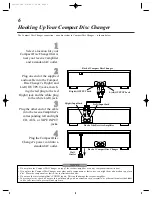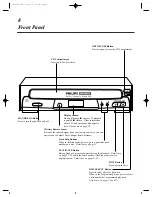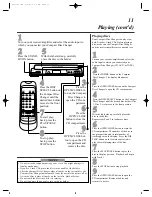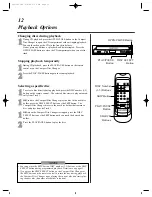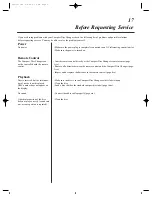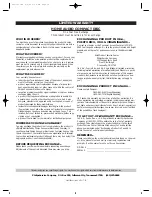
3
Introduction
Welcome to your Compact Disc
Changer owner’s manual. This man-
ual was designed for you. When
looking through it, it will help you to
keep several things in mind.
One, this manual is divided into four
sections. The Getting Started section
guides you through the initial setup
of your Compact Disc Changer. The
Operating Your Compact Disc
Changer section shows you all of the
controls of the Compact Disc
Changer and remote control and
guides you through the simple oper-
ations of your Compact Disc
Changer. The Doing More section
guides you through the more
advanced features of your Compact
Disc Changer. Finally,
the
Information
You May Need section
provides information you may or
may not need – the warranty, for
example, and trouble checks.
Two, the instructions follow a simple
format. Detailed steps explaining
operations are on the outside edges
of pages. Illustrations accompanied
by brief steps explaining operations
are on the inside edges of pages.
Additional information can be found
in boxes labeled NOTES, which are
along the lower edges of pages.
Finally, never be afraid to try a fea-
ture! You cannot hurt your
Compact Disc Changer by trying
any of the features in this manual!
So read on – and relax.
• Before doing anything else, record the
Compact Disc Changer’s model and
serial numbers in the spaces provided
on page two. These numbers will help
us assist you if you ever call for help.
NOTE
• Wireless Remote Control
• Automatic Search Music System
• Audible Search
• Repeat Play
• Random Play
• Programmed Play
FCC Warning: Any unauthorized changes or modifications to
this equipment void the user’s authority to operate it.
Warning: To prevent fire or shock hazard, do not expose this
equipment to rain or moisture.
Philips Consumer Electronics Company recommends that you
use only compact discs which are labeled with the mark.
Warning: This unit uses a laser. Because of possible eye injury,
only a qualified service person should remove the cover or
attempt to service this device.
Caution: The use of controls or adjustments, or the performance
of procedures other than specified herein, can result in hazardous
exposure to laser light.
This digital apparatus does not exceed the Class B limits for radio
noise emissions from digital apparatus.
Radio/TV Interference
This equipment has been tested and found to comply with the lim-
its for a Class B digital device, pursuant to Part 15 of the Federal
Communications Commission Rules. These limits are designed to
provide reasonable protection against harmful interference in a
residential installation. This equipment generates, uses, and can
radiate radio frequency energy and, if not installed and used in
accordance with the instructions, may cause harmful interference
to radio communications. However, there is no guarantee that
interference will not occur in a particular installation. If this
equipment does cause harmful interference to radio or television
reception, which can be determined by turning the equipment off
and on, the user is encouraged to try to correct the interference by
one or more of the following measures:
1) Reorient or relocate the receiving antenna.
2) Increase the distance between the equipment and the receiver.
3) Connect the equipment to an outlet on a circuit different from
the circuit to which the receiver is connected.
4) Consult the dealer or an experienced radio/TV technician for
help.
Copyright 1998 Philips Consumer Electronics Company. All
rights reserved.
Features
Safety Precautions
CDC735comb 4/9/99 5:39 PM Page 3






